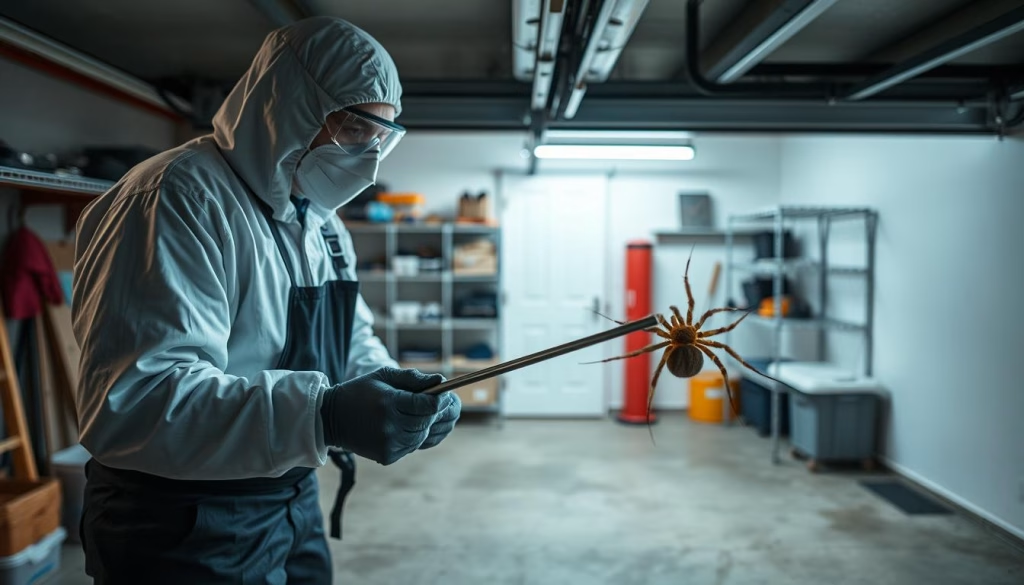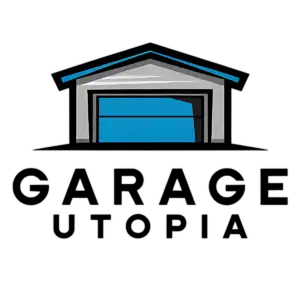Spiders in your garage can be a persistent issue, but this guide offers straightforward solutions to address infestations. Whether you’re dealing with webs, egg sacs, or frequent sightings, we outline actionable steps to eliminate spiders and prevent their return.
From cleaning routines to targeted treatments, this article breaks down methods that prioritize safety and effectiveness. Discover how to get rid of spiders in garage through simple DIY strategies and professional services tailored for lasting results.
Understanding Why Spiders Invade Your Garage
Garages often become spider hotspots due to ideal living conditions. Darkness, dampness, and clutter create perfect habitats. Spiders seek damp areas for moisture and dark corners to build webs. Cluttered spaces hide their prey, like insects, making garages a food source. These factors drive infestations, so addressing them is key to effective spider infestation solutions.
Common garage spiders include house spiders, which build messy webs, and wolf spiders hunting on floors. Black widows or brown recluses may also appear, with dangerous bites. Identifying species helps assess risks. Web patterns and body features—like red marks on black widows—aid recognition.
Maintaining a clean, dry garage reduces spider appeal. Removing insect prey through sealing cracks or using traps helps. Early action prevents severe infestations, ensuring safer storage and peace of mind. Combining awareness with targeted spider infestation solutions stops spiders from returning.
Basic Prevention Methods for Spiders
Preventing spiders in garage spaces starts with simple, consistent actions. Regular cleaning removes dust and debris where spiders hide. Sweep floors weekly and wipe down surfaces to eliminate cobwebs. Clutter creates hiding spots, so store items in sealed plastic containers. Elevate stored boxes off the floor to reduce shelter options.
Seal entry points to block spider access. Check garage doors for gaps and install weatherstripping. Caulk cracks around windows and repair torn screens. Use steel wool or caulk to close gaps where pipes or wires enter the garage. These steps block common entry routes spiders use.
Organizing tools and equipment reduces dark, undisturbed zones. Keep shelves tidy and avoid piling items in corners. Regularly inspect storage areas to disrupt spider activity early. Garage spider prevention techniques also include reducing outdoor attractants—trim vegetation near the garage to limit insect populations spiders feed on.
Maintain these practices monthly to keep results lasting. Combining cleaning, sealing, and smart storage forms a barrier against infestations without harsh chemicals. Consistency in these methods creates a long-term solution for a spider-free space.
Natural Spider Repellents
Protect your garage without harsh chemicals using natural spider deterrents. These eco-friendly solutions are safe for families and pets while keeping spiders at bay. Essential oils like peppermint, tea tree, and lavender act as powerful repellents. Mix 10-15 drops of any oil with water in a spray bottle. Spray corners, doorways, and storage areas weekly to maintain effectiveness.
Vinegar solutions also work well. Combine equal parts white vinegar and water, then spray problem areas. Clean surfaces weekly to disrupt spider trails. Diatomaceous earth, a powder made from fossilized algae, damages spiders’ exoskeletons. Sprinkle lightly in hidden spots like behind shelves. Avoid inhaling the dust.
Cedar blocks or oil-infused cedar chips release aromatic compounds spiders dislike. Place near entry points. Horse chestnuts scattered around entryways repel spiders naturally. Crushed citrus peels, such as lemon or orange, emit strong scents that deter them too. Replace peels weekly for continuous protection.
Natural spider deterrents require consistent use. Combine methods for best results. Peppermint sprays paired with vinegar cleaning create a layered defense. Always test oils on surfaces before full application. These options provide a safe, chemical-free way to reduce spider activity in your garage.
Chemical Solutions to Eliminate Spiders
When natural methods fall short, chemical treatments offer targeted solutions for spider control in garage spaces. Residual sprays like Spectracide’s insecticide or Ortho Home Defense create long-lasting barriers, repelling spiders for weeks. Dust treatments, such as Drione Insecticide Dust, work well in hard-to-reach areas, clinging to surfaces to disrupt spider activity. Foggers, including Hot Shot Fogger, disperse pesticides throughout the garage, targeting hidden infestations.

Always prioritize safety when using chemicals. Apply sprays outdoors or in well-ventilated areas. Wear gloves and a mask during application. Store pesticides securely away from children and pets. Test treatments on small surfaces first to avoid damaging materials. Follow label instructions precisely, as overuse may harm non-target insects or pose health risks.
While chemical methods offer quick results, their effectiveness varies by spider type and infestation size. Combining these products with regular garage cleaning and sealing entry points ensures lasting spider control in garage environments. Regular inspections after treatment help identify areas needing reapplication. Remember, chemical use should complement—not replace—preventative measures for sustainable results.
Traps You Can Use in Your Garage
Combatting spiders requires effective trapping methods. Commercial sticky traps, like Catchmaster or Tangle-Trap brands, catch spiders while monitoring infestation levels. Place these along walls or entryways for best results. Regular checks every 3–4 days ensure timely disposal and trap freshness.
For DIY spider extermination, create vinegar-soaked cotton balls in sealed jars with small entry holes. Spiders are attracted to the scent but can’t escape. Alternatively, coat the insides of plastic containers with petroleum jelly—position near dark areas like storage shelves. Vacuum traps work by suctioning spiders directly; target webs immediately after use to prevent escape.
Position traps in corners, under sinks, or near garage doors where spiders travel. Replace traps weekly to maintain effectiveness. Dispose of full traps in sealed bags to avoid reinfestation. Remember, traps alone aren’t a full solution—they work best with other DIY spider extermination strategies like sealing entry points and reducing insect populations.
Professional Pest Control Options
When DIY spider removal tips fail, professional pest control offers reliable solutions. Experts handle severe infestations, especially when dangerous species like black widows or brown recluses are present. Persistent webs or spiders in hard-to-reach areas may require specialized tools and chemicals.

Professional services start with a thorough inspection to locate entry points and nests. Technicians may use insecticides, dust treatments, or exclusion methods to eliminate spiders safely. Customized plans address your garage’s unique risks, followed by scheduled follow-ups to ensure results.
Costs vary based on garage size, infestation severity, and treatment type. Expect higher fees for eco-friendly options or guarantees. Reputable companies like Orkin or Terminix provide transparent pricing and certifications. Ask about warranties, safety protocols, and eco-impact before hiring.
Professional help ensures long-term prevention, combining treatments with advice to reduce future risks. These services are vital when safety is a concern, making them a smart investment for lasting spider removal tips.
Maintaining a Long-Term Spider-Free Garage
Regular cleaning forms the backbone of getting rid of garage spiders efficiently. Schedule monthly sweeps to remove webs, clutter, and debris where spiders hide. Use a broom, vacuum, or duster to target corners, shelves, and ceiling edges. Sticky traps placed along entry points can also help monitor activity without disrupting ongoing prevention efforts.
Seasonal inspections are key. Spring and fall see increased spider activity, so check garage seals, vents, and storage areas quarterly. Fix cracks in foundations or windows to block entry points. Trim plants near the garage to eliminate outdoor habitats that attract insects spiders feed on.
Year-round measures include using silica gel dust in dark zones or hanging sticky mats near doors. Adjust outdoor lighting to reduce flying insects—spiders follow their prey. Dehumidifiers can lower moisture, making garages less inviting. Maintain these steps consistently to break spider return cycles.
Combining these practices creates barriers spiders can’t breach. A disciplined routine ensures your efforts in getting rid of garage spiders efficiently don’t fade over time. Persistence in maintenance turns short-term fixes into lasting solutions.
Addressing Potential Food Sources for Spiders
Spiders rely on insects and pests for survival. Reducing their food supply makes your garage less appealing. The best spider repellents work best when paired with strategies targeting their prey. Start by eliminating insects that attract spiders.
Outdoor lights attract moths and beetles. Switch to yellow “bug lights” to cut nighttime insect activity. Seal gaps around windows and doors to block entry points for both insects and spiders. Outdoor insecticides labeled for perimeter use can further reduce pest populations.
Moisture attracts cockroaches and ants. Fix leaks under sinks and use dehumidifiers. Dry conditions reduce insect breeding sites, limiting food sources. Trim shrubs and remove leaf piles near the garage to remove insect habitats.
Rodents like mice leave droppings that feed cockroaches. Use snap traps or bait stations to control rodent populations. Seal gaps larger than 1/4 inch to block entry. Fewer rodents mean fewer spiders hunting their nests.
Monthly inspections check for new pest activity. Vacuum corners weekly and replace weatherstripping yearly. Combining these steps with the best spider repellents builds a layered defense. Starving their food chain forces spiders to relocate permanently.
Understanding the Ecological Role of Spiders
Spiders in garages often viewed as pests, but they play a vital role in ecosystems. They prey on insects like mosquitoes, flies, and moths. This natural control reduces the need for chemical pesticides. Their presence can also indicate a healthy outdoor environment.
Effective spider management requires balancing pest control with ecological health. Target only problem areas and avoid broad-spectrum pesticides that harm beneficial species. Identify harmful species versus harmless ones, like cellar spiders that don’t pose risks.
Responsible approaches focus on reducing infestations without harming biodiversity. Regular inspections and targeted treatments maintain ecological balance. Prioritize selective solutions to protect both home and the environment. When considering how to get rid of spiders in garage, assess whether their presence offers ecological benefits first.
Some species help control nuisance insects without human intervention. Only address infestations when spiders become a health concern or overpopulate. This strategy supports long-term environmental health while addressing how to get rid of spiders in garage effectively.
Final Tips for Keeping Your Garage Spider-Free
Effective spider control in garage demands consistency. Use the methods covered—like sealing entry points, removing webs, and using repellents—to build a routine. Start by picking strategies that work best for your space and schedule regular checks every two weeks.
Create a cleaning log to track vacuuming, decluttering, and pesticide applications. Include seasonal tasks like fall or spring cleanouts. This plan keeps spider control in garage organized and prevents gaps in maintenance.
Monitor corners, shelves, and storage areas weekly. Early signs like fresh webs or small egg sacs mean action is needed. Remove these immediately with a vacuum or broom to stop infestations before they grow.
Encourage natural predators by placing bird feeders or birdbaths near your garage. Birds and lizards eat spiders, reducing their numbers safely. Planting flowers like marigolds around the property can also deter pests that attract spiders.
Spiders return if gaps stay open or clutter piles up. Stick to your cleaning schedule and adjust methods as needed. Combining these steps ensures long-term success in spider control in garage without relying solely on chemicals.













